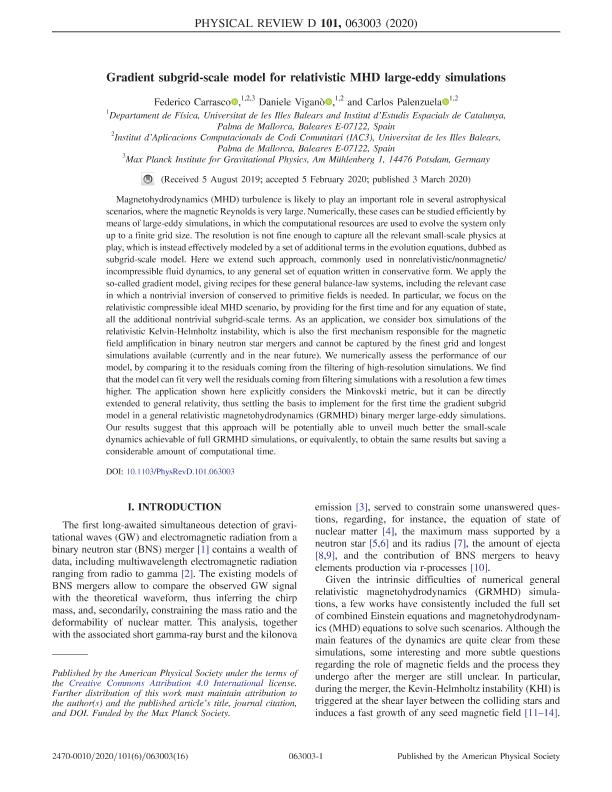Mostrar el registro sencillo del ítem
dc.contributor.author
Carrasco, Federico León

dc.contributor.author
Viganò, Daniele
dc.contributor.author
Palenzuela, Carlos
dc.date.available
2021-11-04T19:38:07Z
dc.date.issued
2020-03-15
dc.identifier.citation
Carrasco, Federico León; Viganò, Daniele; Palenzuela, Carlos; Gradient subgrid-scale model for relativistic MHD large-eddy simulations; American Physical Society; Physical Review D; 101; 6; 15-3-2020; 1-16
dc.identifier.issn
2470-0010
dc.identifier.uri
http://hdl.handle.net/11336/146064
dc.description.abstract
Magnetohydrodynamics (MHD) turbulence is likely to play an important role in several astrophysical scenarios, where the magnetic Reynolds is very large. Numerically, these cases can be studied efficiently by means of large-eddy simulations, in which the computational resources are used to evolve the system only up to a finite grid size. The resolution is not fine enough to capture all the relevant small-scale physics at play, which is instead effectively modeled by a set of additional terms in the evolution equations, dubbed as subgrid-scale model. Here we extend such approach, commonly used in nonrelativistic/nonmagnetic/incompressible fluid dynamics, to any general set of equation written in conservative form. We apply the so-called gradient model, giving recipes for these general balance-law systems, including the relevant case in which a nontrivial inversion of conserved to primitive fields is needed. In particular, we focus on the relativistic compressible ideal MHD scenario, by providing for the first time and for any equation of state, all the additional nontrivial subgrid-scale terms. As an application, we consider box simulations of the relativistic Kelvin-Helmholtz instability, which is also the first mechanism responsible for the magnetic field amplification in binary neutron star mergers and cannot be captured by the finest grid and longest simulations available (currently and in the near future). We numerically assess the performance of our model, by comparing it to the residuals coming from the filtering of high-resolution simulations. We find that the model can fit very well the residuals coming from filtering simulations with a resolution a few times higher. The application shown here explicitly considers the Minkovski metric, but it can be directly extended to general relativity, thus settling the basis to implement for the first time the gradient subgrid model in a general relativistic magnetohydrodynamics (GRMHD) binary merger large-eddy simulations. Our results suggest that this approach will be potentially able to unveil much better the small-scale dynamics achievable of full GRMHD simulations, or equivalently, to obtain the same results but saving a considerable amount of computational time.
dc.format
application/pdf
dc.language.iso
eng
dc.publisher
American Physical Society

dc.rights
info:eu-repo/semantics/openAccess
dc.rights.uri
https://creativecommons.org/licenses/by-nc-sa/2.5/ar/
dc.subject
MAGNETOHYDRODYNAMICS
dc.subject
TURBULENCE
dc.subject
SUB-GRID-SCALE MODEL
dc.subject
LARGE-EDDY SIMULATIONS
dc.subject.classification
Física de los Fluidos y Plasma

dc.subject.classification
Ciencias Físicas

dc.subject.classification
CIENCIAS NATURALES Y EXACTAS

dc.title
Gradient subgrid-scale model for relativistic MHD large-eddy simulations
dc.type
info:eu-repo/semantics/article
dc.type
info:ar-repo/semantics/artículo
dc.type
info:eu-repo/semantics/publishedVersion
dc.date.updated
2021-09-06T16:40:10Z
dc.identifier.eissn
2470-0029
dc.journal.volume
101
dc.journal.number
6
dc.journal.pagination
1-16
dc.journal.pais
Estados Unidos

dc.journal.ciudad
Maryland
dc.description.fil
Fil: Carrasco, Federico León. Universitat de les Illes Balears and Institut d’Estudis Espacials de Catalunya; Departament de Física; Palma de Mallorca; España. Max Planck Institute for Gravitational Physics; Alemania. Consejo Nacional de Investigaciones Científicas y Técnicas. Centro Científico Tecnológico Conicet - Córdoba. Instituto de Física Enrique Gaviola. Universidad Nacional de Córdoba. Instituto de Física Enrique Gaviola; Argentina
dc.description.fil
Fil: Viganò, Daniele. Universitat de les Illes Balears and Institut d’Estudis Espacials de Catalunya; Departament de Física; Palma de Mallorca; España. Universitat de les Illes Balears; Institut d’Aplicacions Computacionals de Codi Comunitari (IAC3); España
dc.description.fil
Fil: Palenzuela, Carlos. Universitat de les Illes Balears and Institut d’Estudis Espacials de Catalunya; Departament de Física; Palma de Mallorca; España. Universitat de les Illes Balears; Institut d’Aplicacions Computacionals de Codi Comunitari (IAC3); España
dc.journal.title
Physical Review D
dc.relation.alternativeid
info:eu-repo/semantics/altIdentifier/doi/http://dx.doi.org/10.1103/PhysRevD.101.063003
dc.relation.alternativeid
info:eu-repo/semantics/altIdentifier/arxiv/https://arxiv.org/abs/1908.01419
dc.relation.alternativeid
info:eu-repo/semantics/altIdentifier/url/https://journals.aps.org/prd/abstract/10.1103/PhysRevD.101.063003
Archivos asociados
